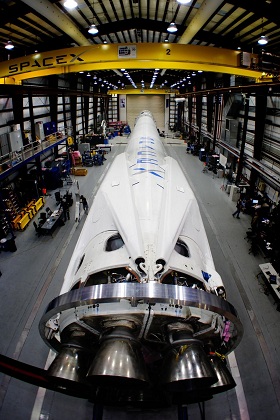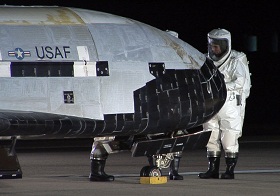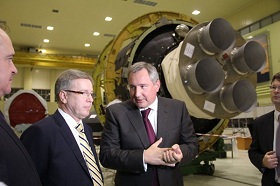Public and Private Space: Russian Competitive Opportunities
The SpaceX Dragon commercial cargo craft is
grappled by the Canadarm2 robotic arm at
the International Space Station.
(no votes) |
(0 votes) |
PhD in Political Science, Independent expert
In the last ten years we have witnessed a genuine revolution in private astronautics. The revolution began in the United States, but now is shaping different approaches around the world to the use and development of space, including scientific and technological policies pursued by states and competition between them in this field. Alongside the rapid growth in the commercial space sector, several other qualitative changes are currently taking place with regards to space technology. Of course, all these changes cannot but affect Russia and its long-term interests.
In the last ten years we have witnessed a genuine revolution in private astronautics. The revolution began in the United States, but now is shaping different approaches around the world to the use and development of space, including scientific and technological policies pursued by states and competition between them in this field. Alongside the rapid growth in the commercial space sector, several other qualitative changes are currently taking place with regards to space technology. Of course, all these changes cannot but affect Russia and its long-term interests.
Commercial Space Revolution
Since the very beginning of space exploration, private companies have acted as contractors for public space programs, as well as designed and built their own spacecraft to provide relevant services. It should be noted that state orders covered the development and construction of carrier rockets and other means of launching payloads, various satellites, scientific devices, cargo and manned spacecraft and orbital stations. On the other hand, the telecommunications sector – the design, development and operation of communications and broadcast satellites – has been very attractive for private investment beginning in the 1960s and continuing over the next 35-40 years.
Unlocking the economic value of space activities and the commercialization of technologies developed through government contracts in the aerospace industry helped create the preconditions for changes during the late 1980s. The sector was increasingly perceived in terms of profit potential. The role of the Cold War as a powerful incentive for massive government investment in space programs should not be underestimated either, but during the wane of this period of confrontation, the Soviet Union and the United States paid more and more attention to the surplus value created by every ruble or dollar invested in such programs.
In addition to the thrifty attitude of superpowers towards their space expenditures, the “revolution in military affairs” that had started during these years made a significant contribution as well. The integration of space communication, reconnaissance and navigation systems into the everyday activities of the armed forces and the emergence of the phenomenon of high-tech warfare [1] required the involvement of civilian personnel and the use of commercial communications satellites by troops.
It was the war in Iraq in 1991 that opened a new era, having demonstrated that no army can fully meet its needs for space systems through the use of exclusively military vehicles, mostly due to their high costs. On the other hand, it became clear that, for example, navigation satellite systems (at that time these were the American GPS and the Russian/Soviet system, later known as GLONASS), the creation and maintenance of which were not commercially profitable, should be part of the civil and economic infrastructure, such as roads and electrical networks. The development of this technology made land remote sensing satellites an important part of such infrastructure and even a separate segment of the space business, allowing for pictures to be taken of the Earth surface in high resolution and data to be transmitted in real-time to a wide range of customers. Initial satellite surveys of the planet’s surface had previously only been carried out for intelligence purposes.
The collapse of the Soviet economic system and the development of the world market for space products and services became additional powerful incentives for the development of commercial astronautics. As expected, Russian and Ukrainian companies entered the market with their carrier rockets and rocket engines. A little later they were joined by China, carrying out commercial launches of satellites with its rockets and producing satellites for customers in Africa and Latin America. Russia also became a pioneer in the commercialization of orbital stations and paved the way for the space tourism industry (this started back at the Mir space station).
The end of the Cold War released many specialists employed in government programs from the aerospace industries in the U.S. and Russia. And we have to hand it to the Americans for creating conditions for some of these people to remain in the profession and switch over to the commercial space sector or set up their space companies. This is how the “ecosystem” of private space exploration came into existence.
And yet, the starting point of the revolution in the commercial astronautics was 2001, when the totally private sub-orbital aircraft SpaceShipOne [2] made its maiden flight. The aircraft was funded by billionaire Paul Allen and formed the basis for the project to build a ship for mass space tourism. The newly created company Virgin Galactic, run by billionaire Sir Richard Branson, undertook this project, called SpaceShipTwo [3], together with P. Allen. A year later, another business magnate Elon Musk founded Space Exploration Technologies, which eventually developed a family of Falcon [4] launch vehicles and Dragon [5] free-flying spacecraft designed to deliver both cargo and people to orbiting destinations.
It should be emphasized that private capital began to make venture investments in space transportation with the purpose of reducing the cost of deliveries of cargo and people into orbit and their safe return to Earth. Thus, the Falcon 9 cost of cargo delivery into low earth orbit is 4300 USD/Kg, while the corresponding figure for the Falcon Heavy rocket has already been reduced to 1455 USD/Kg [6]. In contrast, the cost of launching cargo into low earth orbit by the Russian rocket Proton-M is 2600-4500 USD/Kg [7].
The role of the state in these endeavors should not be underestimated. In the 2000s, the U.S. government adopted the Constellation Program (the so-called George W. Bush Moon Program) and within its framework transferred business technologies and experience accumulated over decades. The program actually waived its own new projects in the field of manned astronautics and rocket production in favor of orders for services of commercial space systems. By doing so, it partially “insured” business investments.
At the same time, the U.S. space agency NASA received the opportunity to focus on fundamental space research and the integration of civil and military space research results into the aviation sector. In this regard, it is appropriate to mention experimental high-altitude unmanned solar-powered aircraft, the adaptation of military unmanned aircraft air and space systems for the needs of the business sector, as well as flying wing technology, first used on military aircraft and space shuttles, for civil aircraft construction [9]. These developments must be taken into consideration, as space and aviation industries require synergies, which creates a basis for their mutual technological enrichment and acts as a key driving force behind economic development.
Areas of Global Competition
We can single out three main areas of space activities carried out by the major foreign actors.
Deep space exploration. This area involves the sending of spaceships to other bodies of the Solar System – the Moon, asteroids, Mars, other planets and their satellites. Current participants are the United States, Europe, Japan, China and India. However, the objectives of the actors differ. While Americans and Europeans are carrying out very complex missions to maintain their scientific and technological leadership, the Chinese and Indian projects are less ambitious, since their main goal is to advance their own technological and industrial potential. However, China’s launch in December 2013 of the lunar probe Chang'e-3, encompassing a lander and a moon rover called “Yutu” [10], coupled with the successful completion in summer 2013 of the manned Tiangong-1 space laboratory program [11], demonstrate that country’s aspiration to become a space power, able to operate in space single-handedly. As for Japan, its goal is to maintain its leadership position in certain technological niches of robotics and natural science, required for mutually beneficial cooperation in space with the U.S. and the EU, as well as for maintaining its superiority in these niches over China.
Astrophysics. At issue here is the study of the Universe, other stellar systems, and the verification of basic concepts of theoretical physics. The leading positions in this field are occupied by the Americans and the Europeans, and other actors cannot compete with them yet. Russia retains the potential of implementing such projects, which corresponds to its vital interests, but needs targeted policies for fundamental space research.
New spacecraft. The leader in this area is the United States, while the European Space Agency carries out significant R&D too. The criterion here is not so much spending on space programs, as the quality and sophistication of devices developed for new scientific space missions [12]. New spacecraft along with new boosters are designed to simplify and reduce the cost of the use of low-earth orbit to solve a variety of applied problems, and to achieve greater flexibility in use, long service life and maintainability.
Special attention should be paid here to the U.S. unmanned re-entry spacecraft X-37B [13], which was designed for the United States Air Force and has already made a series of long experimental orbit flights. The ability to quickly deploy the system of space communication and intelligence over a given area on the earth's surface, which the armed forces need while preparing for and carrying out conflict missions, makes the development of such vehicles particularly promising and valuable.
This system helps solve the problem of capacity shortages in commercial communication channels in the event of hostilities, as well as the problem of satellite systems’ coverage of different regions of the Earth. Currently, the X-37B Orbital Vehicle is being used as an orbital laboratory too, testing new space technologies. The future use of such devices (more advanced than the existing test vehicle) is likely to include the maintenance and upgrading of already deployed satellites and telescopes.
For comparison, the European reusable suborbital shuttlecraft IXV (Intermediate eXperimental Vehicle) [14] is being designed for developing technologies relating to future space transportation systems. At the same time, in early 2014, the Europeans expressed an official interest in the reusable manned Dream Chaser orbital transportation system developed by American Sierra Nevada Corporation [15].
Speaking of the new manned spacecraft, it is worth noting that Boeing is developing a reusable Crew Space Transportation-100 (CST-100) vehicle [16]. The CST-100 can accommodate up to seven passengers or a mix of crew and cargo. Although during the initial stage testing and transporting astronauts will involve the International Space Station (ISS), the vehicle is designed for the maintenance of and passengers’ delivery to a private orbital space station, developed by the American company Bigelow Aerospace [17]. Under the NASA contract, Boeing and Lockheed Martin are involved in building the Orion Multi-Purpose Crew Vehicle [18]. Its flight tests are to begin in 2014. Even though the U.S. has not yet decided on the expediency of a new manned mission to the Moon or to one of the nearby asteroids, the county’s space industry is busy developing basic technologies in this area and reviewing the experience of previous manned space programs.
These areas of global space competition have political consequences. It is easy to notice that, in contrast to the Shuttle–Mir Program and the ISS, there are no new projects today that provide leading space powers with opportunities for cooperation. Different approaches, different goals and different possibilities, including the different institutional arrangements of space activities, are inhibiting efforts to find a common language and common interests in space. However, what seems impossible to achieve at the level of states can be well reached at the level of academic and business communities.
Russia in this New Reality

This conceptual image shows NASA's Orion
spacecraft approaching the robotic asteroid
capture vehicle
Against this backdrop, the space activities of our country have long been characterized by a combination of inertia and attempts to develop new strategies. This situation was caused by changing conditions in the sector. Given the failure of the conversion policy in 1992-1993, a restructuring of the Soviet aerospace industry and its adaptation to the market economy could not happen overnight. In addition, foreign demand for domestic space products in the 1990s, and the continued operation of inefficient enterprises created the false illusion in Russian society that astronautics could exist in our country without the investment of increased resources. Things began to change towards the end of the 2000s, when a series of unsuccessful projects and launch accidents, coupled with changes in the international competitive setup, forced Russia to critically reassess its position in this field.
Today, the Russian government is creating the United Rocket and Space Corporation (URSC), designed to integrate and optimize all state assets in rocketry and spacecraft building. It seems reasonable to assess whether this new structure stands the chance to be competitive, given the international context and the development of private space companies.
The URSC stands a good chance to succeed if it works as a development corporation. First, Russia needs a new family of booster-rockets. The space-launch vehicle Angara [19] is being prepared for flight tests, but it is only the first step on this path. Second, it is the real and not state-subsidized price per kilogram of cargo delivery that should constitute the criterion of success and competitiveness of new launch vehicles. Today, the ultimate goal in this battle for the market is to reduce the price to less than USD 1,000 per 1 kg. Most importantly, the URSC activities should be in line with the national space exploration strategy that has to be worked out and made public. Fundamental research in space and related R&D should form the cornerstone of this work.
It is important for Russia to recognize something that the Americans realized a decade and a half ago: no space activity at state expense, including sending astronauts anywhere, makes any sense if it fails to yield fundamentally new knowledge and technologies. And today this understanding is the basis for goal-setting not only for Americans and Europeans, but also in Beijing, Tokyo, and New Delhi. It would be a grave mistake if the URSC functions in the same paradigm as existing Russian space enterprises and holdings, which maintain productive capacity at the minimum sufficient level and service the needs of government agencies and, at times, state-owned companies. Of course, this approach assumes that the Russian satellite systems for communications and broadcasting should be established by telecommunications companies and major television holdings, rather than at the expense of budgeted government programs.
This basis will allow for the development of new international space projects involving Russia. Although their number is unlikely to become significant in the coming years, a precise definition of objectives, organizational structure and financial plans will allow Russia to maintain and sometimes even improve its leadership position in such projects.
And it should be noted that Russia has the potential for developing private astronautics. Of course, this potential reflects the state and the capabilities of the domestic market, but it is clearly superior to what we see today in Japan, China or India, where there is little ground for even mentioning private space programs. The point at issue is private enterprises created by the Russian scientific community. The first such undertaking worth mentioning is the Selenokhod [20] research team, which in December 2013 participated in the “Google Lunar X-Prize” contest for creating and sending a completely private robot to the surface of the Moon. As a side note, this team has founded a national venture company RoboCV in the field of robotics [21]. Another example of a private Russian space company is Dauria Aerospace, which was founded by billionaire Mikhail Kokorich and has offices in Russia (Skolkovo Innovation Center), Germany and the USA. The company intends to develop and deploy a system of monitoring and communication satellites and provide their services to consumers through electronic subscription.
***
The intensive development of private astronautics, which began in the U.S. in the past decade, is changing the world practice of space exploration today. In fact, we can effectively claim that all the activities on the earth orbit, including manned flights, are commercialized. This has occurred due to the fact that by creating space rockets and devices on the basis of new technologies, private companies have managed to significantly reduce the cost of delivering cargo into orbit. However, the informal status of being the leader in space industry today more than ever depends on the ability of a country or a group of countries to carry out a wide range of fundamental space research, and thus develop the necessary technological and industrial potential.
Russia has a good chance to adapt to world trends in space exploration and take its rightful place in fundamental research and private astronautics by creating the URSC and favorable conditions for setting up space startups in academic environments. A clear and transparent strategy defined by the political leadership and the will to implement it are major preconditions for this success. However, space exploration in general will remain a highly politicized sphere of international relations, and to keep its leadership potential Russia should be able to put forward and realize advanced scientific and technological ideas.
1. In science and political practice, this phenomenon is also known as a “revolution in military affairs,” characterized by a qualitative leap in the information support of troops down to the individual soldier on the basis of satellite communications, control, navigation and intelligence, coupled with the introduction of high-precision weapons and robotic combat systems. For details, see: 1) Keeping the Edge: Managing Defense for the Future / / Preventive Defense Project. Cambridge - Stanford, 2000. p. 316; 2) Adamsky D. The Culture of Military Innovation: The Impact of Cultural Factors on the Revolution in Military Affairs in Russia, the US, and Israel. Stanford University Press, 2010. p. 231.
2. SpaceShipOne & White Knight // Scaled Composites, LLC. URL: http://www.scaled.com/projects/tierone/
3. SpaceShipTwo // Spaceships / Virgin Galactic. URL: http://www.virgingalactic.com/overview/spaceships/
4. Falcon 9 // Space Exploration Corporation. URL: http://www.spacex.com/falcon9/
5. Dragon // Space Exploration Corporation. URL: http://www.spacex.com/dragon
6. Capabilities & Services // Space Exploration Corporation. URL: http://www.spacex.com/about/capabilities
7. This spread in figures is due to the lack of clearly defined launching prices of the Proton-M carrier rocket. The lower limit is based on published data on the cost of launch under the state contract, which does not take into account indirect costs (personnel, infrastructure, etc.), as the latter is paid for by the state under other expenditure commitments (see: Stoimost' «Protona-M» i sputnikov prevyshala 4 mlrd. vmeste s zapuskom // Gazeta.ru, . 02.07.2013. URL: http://www.gazeta.ru/social/news/2013/07/02/n_3012305.shtml. The upper limit is based on approximate cost of the commercial launch of the rocket (see: Raketa-nositel Proton-M za 10 let podorozhala v 5 raz // Forbes. 09.03.2013. URL: http://www.forbes.ru / news/235377-raketa-nositel-proton-m-za-10-let-podorozhala-v-5-raz.
8. See, for example, 1) Report of the President’s Commission on Implementation of United States Space Exploration Policy. A Journey to Inspire, Innovate, and Discover. Washington, June 2004; 2) U.S. Space Transportation Policy. Washington, January 6, 2005; 3) U.S. National Space Policy. Washington, August 31, 2006.
9. See, for example, Fundamental Aeronautics // NASA. URL: http://www.aeronautics.nasa.gov/fap/feature.html.
10. China launches Lunar Probe Chang'e-3 / / Xinhua. URL: http://www.xinhuanet.com/english/special/change3/ (last visit - April 8, 2014). Please, note that this is a special electronic resource of the Chinese news agency Xinhua portal on Chang'e-3 'and moon rover Yutu for those who do not speak Chinese. The information on this portal is official.
11. Shenzhou-10: Chinese capsule docks with space laboratory // BBC. 13 June 2013. URL: http://www.bbc.com/news/world-asia-china-22871325
12. To date, more than 10 NASA spaceships are currently orbiting Earth, the Moon, Mars, and Saturn, on working the surface of Mars, as well as are on their way to other planets of the Solar System to conduct fundamental research. Another series of scientific missions is being prepared for launches in the coming years. The European Space Agency is carrying out eight fundamental scientific missions and is preparing to launch seven more research vehicles into Earth orbit and deep space before 2020 (according to NASA, http://www.nasa.gov/missions/index.html) and ESA (http://sci.esa.int/home/51459-missions/).
13. X-37B Orbital Test Vehicle // Defense, Space & Security / Boeing Company. URL: http://www.boeing.com/boeing/defense-space/ic/sis/x37b_otv/x37b_otv.page?
14. IXV: Intermediate Experimental Vehicle // European Space Agency. 2013. URL: http://esamultimedia.esa.int/multimedia/publications/ixv/
15. Helping make Dream Chaser a reality // European Space Agency. 08 January 2014. URL: http://www.esa.int/Our_Activities/Human_Spaceflight/International_Space_Station/Helping_make_Dream_Chaser_a_reality
16. Commercial Crew // Being Company. URL: http://www.boeing.com/boeing/defense-space/space/ccts/index.page?
17. Bigelow Aerospace, LLC. URL: http://www.bigelowaerospace.com/index.php
18. See: 1) Orion Multi-Purpose Crew Vehicle // Lockheed Martin Corporation. URL: http://www.lockheedmartin.com/us/products/orion.html; 2) Space Launch System // Boeing Company. URL: http://www.boeing.com/boeing/defense-space/space/sls/index.page?
19. Na kosmodrome Plesetsk prodolzhajutsja ispytanija KRK “Angara” // Khrunichev State Research and Production Space Center. April 7, 2014. URL: http://www.khrunichev.ru/main.php?id=1&nid=3023
20. Selenokhod vyshel iz GLXP // Blog Selenokhod Google Lunar X Prize Team. December 25, 2013. URL: http://selenokhod.livejournal.com/
21. RoboCV Ltd. / RoboCV LLC. URL: http://robocv.ru/
(no votes) |
(0 votes) |










